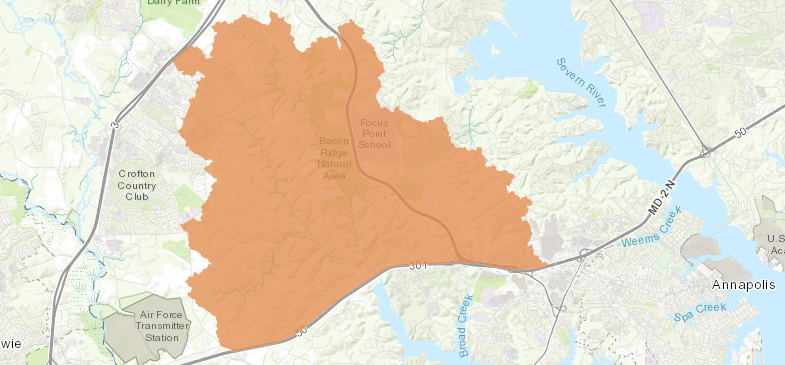
South River Greenway
Scenic Rivers has identified the South River Greenway as a priority area for conservation. We work with landowners in this area to put conservation easements on their property in order to help preserve the rural and natural character for which the area is known.
History of the South River Greenway
In 2005, Scenic Rivers kicked off a public/private partnership to preserve land in the headwaters of the South River. The initiative, which came to be known as the South River Greenway, has components of land protection, habitat assessment, habitat restoration and community outreach. We convened a consortium of partners to develop the South River Greenway concept and released the first Conservation Plan for the greenway. Leaders of the initiative include Anne Arundel County Department of Recreation and Parks, U.S. Fish and Wildlife Service, Arundel Rivers Federation and the Biophilia Foundation.
What is a "greenway"?
A greenway, simply put, is a large area of land that is mostly undeveloped. It is mostly nature intact—large tracts of forests, areas of wetland and prolific wildlife. Importantly, a greenway is tied to a watershed.
The South River Greenway is located at the headwaters of the South River, a tributary of the Chesapeake Bay, in Anne Arundel County. A rough triangle bounded by General’s Highway on the east, Route 3 on the north, Davidsonville Road on the west, and Maryland Route 50 on the south, the South River Greenway is just ten minutes from the state capital in Annapolis and twenty minutes from Baltimore. It spans across multiple zip codes, including Crownsville, Gambrills, Davidsonville and Annapolis.
The 16,000-acre South River Greenway contains four headwater streams and incredible natural resources that provide invaluable ecosystem functions ranging from wildlife habitat to stormwater protection and encompasses numerous cultural resources. The South River Greenway represents millions of dollars of property value and is home to hundreds of county residents.
Over the past 15 years, dozens of organizations and hundreds of individuals have contributed to the protection of the South River Greenway. The South River Greenway’s natural resource attributes include:
- Undeveloped forests covering over 6,000 acres including 2,400 acres of interior forest. The undeveloped land provides watershed protection for the South River and the Chesapeake Bay.
- Two Green Infrastructure forest hubs and many Green Infrastructure corridors as identified by Maryland Department of Natural Resources Greenprint Program and the Chesapeake Bay Program’s Resource Lands Assessment Report.
- 15 different wetland types covering 800 acres.
- 100 miles of perennial and intermittent streams in the South River headwaters.
- A historical spawning area for yellow perch and river herring and habitat for the American eel.
- An Important Bird Area covering 4,792 acres, as identified by Audubon. Eighteen species of Forest Interior Birds nest in the Greenway.
- Four at-risk Forest Interior Dwelling Species (FIDS) are known to occur in the South River Greenway: worm-eating warbler, Kentucky warbler, wood thrush, and Louisiana waterthrush.
- Eight other bird species nest in the South River Greenway that are of high or highest priority, in particular the extensive shrub habitat attracts forest shrub nesters such as hooded and black and white warblers.
- According to a report of biodiversity in the Mid-Atlantic region by U.S. Fish & Wildlife Service and the U.S. Geological Survey, the Greenway is a regionally important area for reptiles and birds.
The heart of the Greenway is the wooded 630-acre Bacon Ridge Natural Area, owned by Anne Arundel County, managed by the Department of Recreation and Parks and used as a public park with hiking/biking trails and under easement with Scenic Rivers and Maryland Environmental Trust.
Contact Us
If you own land within the South River Greenway and are interested in permanently protecting your property from development, we can help. Contact us to learn more about our conservation programs.
